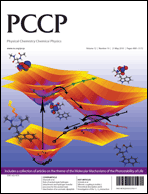PCCP is delighted to announce that this year it is publishing a series of themed issues in the fields of biophysics and biophysical chemistry to highlight some of the great content we publish in this area.
The series contains issues on a variety of topics in this exciting multidisciplinary research area.
 Take a look today at the issues that are already published:
Take a look today at the issues that are already published:
And sign-up to our contents e-alerts to have the upcoming issues sent direct to your inbox:
- Water in biological systems
- Advances in Mass Spectrometry for Biological Science
- Homochirality and Origin of Life
- Nano-bio: The interface between bio-systems and nano-devices
This high-profile series is Guest Edited by PCCP Advisory Board member Seong Keun Kim (Seoul National University, Korea), Jean-Pierre Schermann (Université Paris 13, France), and Taekjip Ha (University of Illinois, USA). The series also contains an issue on molecular mechanisms of the photostability of life Guest Edited by Andrzej Sobolewski and Wolfgang Domcke.
We believe that this series of themed issues will serve to foster links between the biophysics and biophysical chemistry research communities and will have a valuable and lasting impact in this research field.











 Prediction of the structures at the atomic level of molecules and materials remains one of the core challenges of chemistry. Computational chemistry and physics have given us powerful tools over the last few decades for accurate modelling of atomic level structures. But how far can we predict structures? That is, to what extent are we able, given knowledge of the chemical composition of a system, to identify reliably the thermodynamically stable structure?
Prediction of the structures at the atomic level of molecules and materials remains one of the core challenges of chemistry. Computational chemistry and physics have given us powerful tools over the last few decades for accurate modelling of atomic level structures. But how far can we predict structures? That is, to what extent are we able, given knowledge of the chemical composition of a system, to identify reliably the thermodynamically stable structure?